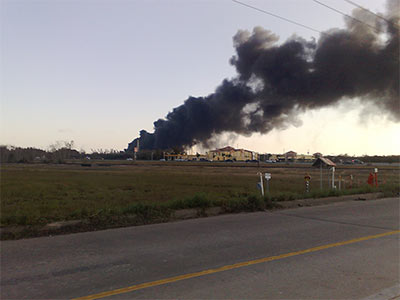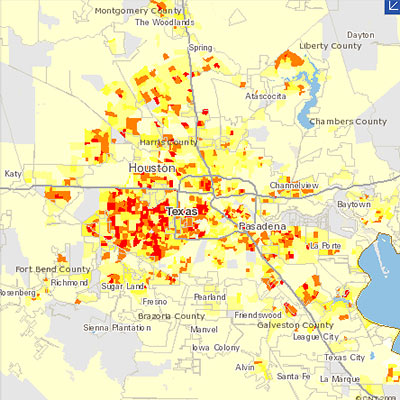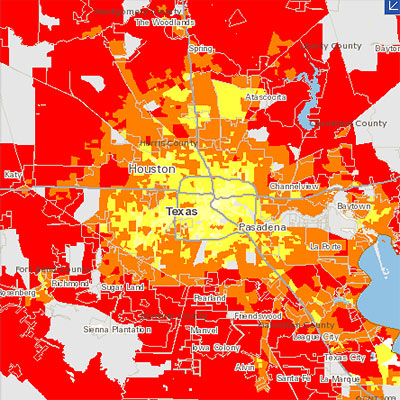THE GIFT OF BENZENE What’s that faint, slightly sweet smell in the air? More from Chris Vogel’s report on Houston’s industrial emissions: “According to the City of Houston, a six-month survey in 2008 showed that six out of seven air monitors near the ship channel detected benzene levels above what the EPA says can cause cancer in ten out of every million people. That’s ten times higher than what is considered an acceptable risk. ‘Until recently I didn’t even know they were releasing any benzene into the atmosphere,’ says Dr. Charles Koller, a leukemia specialist at MD Anderson. ‘It’s shocking to me. It seems, frankly, criminal.’ It can take more than ten years for anemia to develop in someone who has been exposed to benzene, says Koller, and even longer for leukemia. A person also needs to be genetically susceptible. ‘We don’t know how susceptibility works,’ he says, ‘we just know that it works.’ . . . ‘Once benzene gets in the air,’ [Koller] says, ‘it’s everywhere. So even in Katy, there’s someone who, if they’re susceptible, will get [sick] from what’s going on in the Houston Ship Channel.’” [Houston Press]
Air Quality
HOW THE TCEQ HELPS HOUSTON AIR STAY SO FRESH AND CLEAN Combing through emissions reports for 20 local refineries and chemical plants from February 2003 through October of this year, reporter Chris Vogel notes how the peculiar accounting method employed by the Texas Commission on Environmental Quality seriously underrepresents Houston-area emissions events: “In slightly more than six and a half years, the 20 plants pumped out 4,864,730 pounds of sulfur dioxide, 452,080 pounds of carcinogens and a total of 20,716,547 pounds of pollutants during emission events . . . The Press discovered that individual chemicals at the 20 facilities exceeded the limit 12,701 times during the six and a half years. [But] TCEQ documents obtained through an open records request for the 20 plants show that the agency found 469 violations over the past six and a half years, 240 of which listed excess pollution during an emission event as the reason. Those 240 violations represent less than 2 percent of the number of times that individual pollutants exceeded their limit during emission events. Many people, including former TCEQ Commissioner Larry Soward, see this as one of the ways TCEQ gives industry a big break.” [Houston Press]

Here’s a view from a Seabrook resident’s home this morning, looking across the way to the American Acryl acrylic-acid plant at 11600 Port Rd. off Old Texas 146, less than a mile east of the newer Hwy. 146. A loud chemical explosion is certainly a lot to get excited about in the morning, but people in the area may just want to go back to bed:
Area residents were asked to shelter in place after the blast, but that recommendation was lifted by 11 a.m. Officials said the blast involved toluene, a toxic substance that can cause nausea and tiredness in low to moderate levels.
However, in a recorded message company said the explosion did not cause a release of the chemical.
Update: From NASA engineer Jim Thompson, here’s a collaborative map showing the observations of people nearby, including a photo of the blast as seen from the Johnson Space Center.
- No serious injuries reported in Seabrook explosion [Houston Chronicle, via Hair Balls]
Photo: Twitpic user nelagster
FAILING THE PARTICLE BOARD REVIEW Levels of soot in Houston now exceed the EPA’s longstanding annual limit: “The area of concern is along the Ship Channel, the only place in Texas where levels of the tiny particles surpassed the EPA’s annual limit from 2006 to 2008, according to the most recent data available. The agency uses a three-year average to determine whether an area is in compliance. Monitoring shows air near the Ship Channel is getting cleaner, thanks in part to new rules for idling trucks and the paving of gravel parking lots. But EPA and local officials don’t know whether the improvements will be enough to drop the rolling average below the annual limit of 15 micrograms per cubic liter of air, since that average includes higher 2006 levels.” [Houston Chronicle; previously on Swamplot]
CEDAR BAYOU AIR UPSETS The Sierra Club and a Texas environmental group have filed suit against Chevron Phillips claiming a bonus supply of air pollutants and toxic chemicals has been escaping from the company’s Cedar Bayou chemical plant just north of I-10 in Baytown: “‘Like many companies in Texas, Chevron Phillips has repeatedly violated its own permit limits by emitting a wide range of harmful pollutants into the air from the Cedar Bayou plant,’ said Luke Metzger, Director of Environment Texas. ‘Because the state of Texas has failed to stop such violations at Cedar Bayou and elsewhere, citizen groups have had to step up and enforce the law themselves.’ The Clean Air Act contains a ‘citizen suit’ provision that allows private citizens affected by violations of the law to bring an enforcement suit in federal court if state and federal regulators do not. . . . Chevron Phillips’s permits contain both hourly and yearly limits on the amounts of pollutants it can emit into the atmosphere. The lawsuit alleges that equipment breakdowns, malfunctions, and other non-routine incidents at the Cedar Bayou complex have resulted in the release of more than a million pounds of pollutants into the surrounding air, frequently in violation of legal limits. A single such ‘upset’ or ’emission event’ can result in the release of tens of thousands of pounds of air pollutants in a matter of hours or even minutes.” [Environment Texas, via Houston Chronicle]
Katy residents living near a pool supply company got breathtaking views of the spectacular black plumes emanating from the RAM Chemical and Supply warehouse at 4949 Greenhouse Rd. during last weekend’s fire.
But the fun wasn’t entirely over: A separate episode yesterday resulted in a shelter-in-place order for a few hours last night — for downwind neighborhoods east of the Windstone Colony subdivision, stretching from Greenhouse Rd. to Barker Cypress. Fire officials warned of toxic clouds billowing out from a supply of hazardous chemicals still housed in the singed remains of the warehouse.
- Breaking News, Ram Chemical Warehouse Fire! [YouTube]
- RAM Chemical Fire, the Day After [iReport]
- Shelter In Place Order Lifted [Click2Houston]
- Warehouse fire prompts shelter-in-place [abc13]
- Cy-Fair warehouse fire prompts air-quality concerns [Houston Chronicle]
Video: Kevin Neugebauer


The Center for Neighborhood Technology has updated its interactive region-comparison website to show data comparing carbon dioxide emissions around the Houston region. The Housing + Transportation Affordability Index now allows you to compare CO2 emissions — from “household vehicle travel” only — on side-by-side zoomable maps.
The 2 new data sets available show CO2 emissions per acre (at the top above), and CO2 emissions per household (directly below that) from household auto use. The Houston-Galveston-Brazoria region is one of 55 U.S. metropolitan areas mapped on the website. The center’s point?
When measured on a per household basis, it found that the transportation-related emissions of people living in cities and compact neighborhoods can be nearly 70% less than those living in suburbs.
The center figures that transportation accounts for 28 percent of all greenhouse gas emissions in the U.S.
Other H+T map tools focus on how affordable different locations are to live in — when you take transportation costs into account:
WEST U TREATMENT: NOW EVEN MORE SAFE AND SMELLY Noticing anything different about the area around Brays Bayou and Kirby Dr.? “‘It smells like raw sewage,’ said [nearby homeowner Hector] Caram. ‘That’s what it smells like.’ Last month, the city of West University Place cut down the thick crop of trees surrounding its sewage treatment plant on Kirby and North Braeswood within Houston city limits. And for neighbors who live, work or jog around there, the difference is jarring. “You noticed it right away,” said jogger Lauren Cozad. ‘You said, “Oh, why’d they take those trees down,” because we didn’t even know there was anything back there.’ But West University Public Works Director Chris Peifer says his city didn’t have a choice. ‘It is a secure facility,’ said Peifer. Peiffer told us the state ordered the city to clear the fence line here and increase visibility, so security guards can more easily spot anyone trying to break in there. He says it’s a matter of homeland security.” [abc13] Update: As commenter Carol notes below, the Chronicle has more on the story here.
WHAT ABOUT THE FLARES? “An estimated 1,600 tons of smog-forming nitrogen oxides and volatile organic compounds are released in the Houston region each day. They mix with sunlight to form ozone, a colorless gas that can cause lung damage. Formaldehyde and other radical precursors matter because, without them, the volatile organic compounds emitted by cars, industry, paints and other consumer products would form much less ozone, [the Houston Advanced Research Center’s Jay] Olaguer said. Industrial flares burn off pressurized gases but also can shoot out massive amounts of noxious emissions. The Houston area has about 400 flare stacks, and they are among the largest and least- understood sources of pollution in the region, researchers said. A recent University of North Carolina study found that formaldehyde from flares may increase Houston’s ozone by as much as 30 parts per billion. In tandem with the pollution that blows into the region from elsewhere, that might be enough to keep Houston from meeting the new federal ozone limit of 75 parts per billion, scientists said. The state’s current plan for reducing Houston’s smog doesn’t consider formaldehyde and other precursors. ‘If there is a problem with flares, it upends the entire regulatory strategy,’ said Harvey Jeffries, an atmospheric chemist who conducted the UNC study.” [Houston Chronicle, via Off the Kuff]
CHINESE DRYWALL AND THE SMELL TEST The first government report on Chinese drywall is out . . . sort of: “On Monday, Florida’s health department said preliminary tests show there’s no ‘specific’ health hazard associated with the sulfur-based gases coming from the drywall, but the agency is conducting additional tests. ‘It’s not that we are saying it’s safe,’ Florida toxicologist David Krause told reporters on a conference call on Monday. ‘We are moving forward on a much more detailed in-depth’ study. The test results released by the state health department on Monday did make one, definitive conclusion: Chinese-made drywall contained strontium sulfide, a material that’s known to have the odor of hydrogen sulfide in moist air. The U.S-made drywall did not contain this material. The most common evidence of Chinese drywall problems is the corrosion of air conditional equipment, which is turning black and failing repeatedly. Homeowners have also complained about respiratory problems they believe are connected to the drywall.” [Developments]
WHERE’S A STINKIN’ FEMA TRAILER WHEN YOU NEED ONE? Trailer sculptor Paul Villinski, on the difficulty of procuring the raw material for his Emergency Response Studio, now on display at the Rice Art Gallery: “I thought, OK I’m going to go get a FEMA trailer, because they’re selling them online through the government – you know, the GAO Web site – at that very moment, it seemed, FEMA basically stopped releasing the trailers into the marketplace. And not only did they do that, they bought back all the ones that they had already sold. . . . And the back story with that is basically that the plaintiffs in this class-action suit need a couple of FEMA trailers so they can really study the indoor air quality and FEMA and the manufacturers do not want them to have them. So they’ve been ordered by the judge in the case to release the trailers, and they haven’t done it yet. So that made it impossible for me to actually get a FEMA trailer, which is why I wound up finding a 30-foot Gulfstream Cavalier, but it was built a couple of years before the FEMA trailers were.” [Arts in Houston; previously in Swamplot]
SOOT’S US Some public-health and environmental groups are complaining that Houston isn’t getting enough respect for the particularly fine quality of the air here, and are asking the EPA to give this city the recognition it deserves: “Houston’s concentrations of soot — a piercing mix of airborne matter from diesel exhaust, industrial flares and road grit, among other sources — exceeded the EPA’s yearly standards from 2005 to 2007, according to the most recent federal data available. . . . ‘Residents of Houston are breathing unhealthy levels of soot pollution,’ [the NRDC’s John] Walke said in an interview this week. . . . Soot has been a special concern near the Houston Ship Channel, which is home to heavy industry and a busy port. It’s the only place in Texas where the particulate-matter levels exceed the annual standard.” [Houston Chronicle]
HOUSTON LOOKS GOOD IN SOOT Publicizing ozone problems is a smart strategy for Houston, because the city gets to be compared to L.A.! But that’ll get all mucked up if we have to start paying attention to particle pollution too. Fortunately, that isn’t happening quite yet: “In 2006, the EPA lowered the limit on how much soot Americans can be exposed to in 24 hours from 65 micrograms per cubic meter of air to 35. But the agency left unchanged the annual limit — an average of 15 micrograms per cubic meter per day over the course of a year. The agency’s science advisers recommended an annual standard as low as 13 micrograms to protect public health. Since then, Houston’s year-round levels of particles have worsened, averaging about 15 micrograms per day for each year. But the region remains in compliance because the EPA doesn’t plan to look at the cities violating the annual standard until it’s lowered again.” [Houston Chronicle]
BLOWING THIS WAY FROM TEXAS CITY “[Sunday] night for about two hours, BP’s refinery released an estimated 2,725.59 pounds of sulfur dioxide when the pressure spiked during a planned shutdown — so if you were cruising through Texas City and noticed a suffocating smell that may have been it. Meanwhile, starting [Monday], and continuing for the next week, BP has three more emissions events scheduled that are related to maintenance and the aforementioned planned shutdown at the refinery. Through the magic of the Internet, you can determine the substances involved in the releases, which include benzene.” [Hair Balls]

Weary of so many drab and formulaic new kitchens boasting granite countertops and stainless-steel appliances? Thanks to a miracle of modern science journalism, design help is on the way. The tyranny of the knee-jerk Kitchen redo formula may soon be over!
The “Your Granite Countertop May Be Radioactive or Emit Radon” meme got a major boost in the media last week, as an article in the New York Times and separate reports from a Rice University nuclear physicist spawned fears among consumers — and dismissive retorts from industry spokespersons.
No need to panic: Your countertop may not be emitting enough radiation to cook the food you put on it. But hey, maybe you should have your surface tested? The idea of bringing a Geiger counter along on your Home Depot shopping trips conjures up so many exciting possibilities!
Whether the latest concerns indicate a pointless consumer scare or an actual health hazard, the writing is on the wall for the granite-countertop trend, which jumped the shark long ago. In Houston — which has no stone naturally, but where builders love to follow design trends long abandoned elsewhere — they were always a strange import. Cliche-weary designers will likely promote radon-and-radiation fears just to get fashion-handicapped clients to try something else. And solid-surface competitors will only be too happy to take advantage of the situation. But if the 2-decades-long granite-surface craze finally ends, how long will their “Looks Just Like Granite” surfaces be attractive to buyers?
- What’s Lurking in Your Countertop? [New York Times]
- TV request turns into new hobby for nuclear physicist [Rice News]
- Radiation and Radon from Natural Stone [Rice University]
- Be wary of granite that glows [Houston Chronicle]
- The Facts about Granite, Radiation and Radon [Solid Surface Alliance]
- Radon and radiation exposure from granite countertops in indoor applications [BuildClean]
Photo: A2D Construction

